
By Charles Messing, Ph.D. - Professor, Halmos College of Natural Sciences and Oceanography, Nova Southeastern University
July 25, 2015
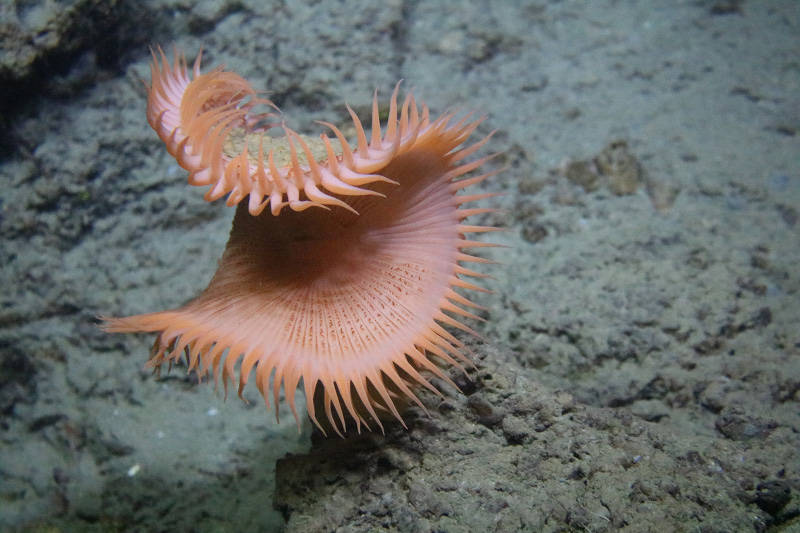
Venus fly trap anemone. Image courtesy of NOAA Bioluminescence and Vision on the Deep Seafloor 2015. Download larger version (jpg, 2.2 MB).
Working as a scientist on a deep-sea expedition offers numerous opportunities for both wonder and satisfaction. I was invited on this cruise because of my (relative) familiarity with deep-seafloor life in the western tropical Atlantic Ocean. My first venture into this environment was aboard the submersible Alvin 40 years ago. But, almost every dive I have since made—whether aboard a sub or from the (relative, again) comfort of a shipboard control booth operating a remote vehicle—has offered a surprise of one sort or another, even when visiting the same study site for the tenth time.
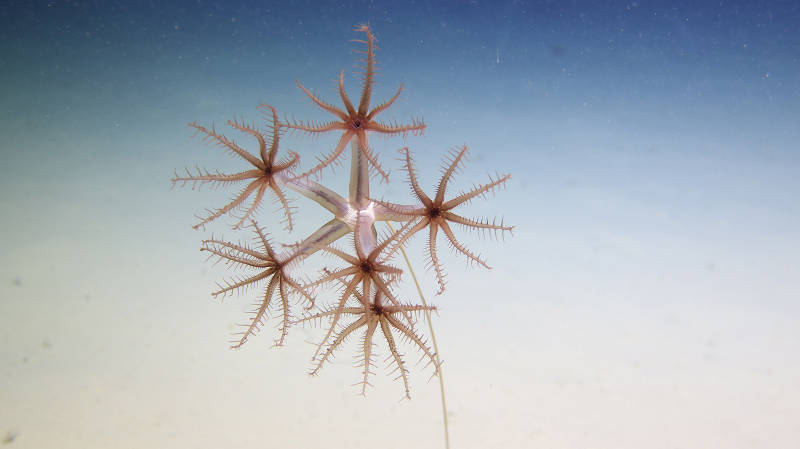
Umbellula sea pen. Image courtesy of NOAA Bioluminescence and Vision on the Deep Seafloor 2015. Download larger version (jpg, 895 KB).
On this expedition, I saw some immediately recognizable old friends: asteroschematid snakestars coiled up in yellow Paramuricea sea fans, delicately coiled Iridogorgia colonies like frozen spiral fireworks displays, and cantankerous Chaceon fenneri—deep-sea golden crabs. As with old friends, some of these are recognizable as they materialize out of the gloom. Others require a closer look—that’s not a clump of sunken Sargassum gulf weed, it’s a glass sponge with, thanks to the amazing zoom close-up capability of the Global Explorer remotely operated vehicle's (ROV’s) cameras, several bright yellow symbiotic amphipod crustaceans inside the sponge’s hollow interior. That’s an example of the wonder component. Fortunately for us, the ROV also has a multi-function manipulator and a series of containers that allow us to collect specimens for study on board ship.
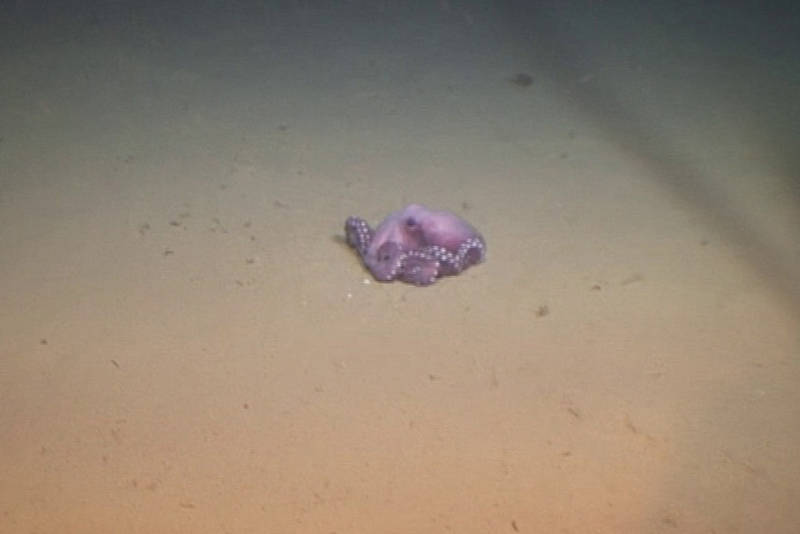
Octopus. Image courtesy of NOAA Bioluminescence and Vision on the Deep Seafloor 2015. Download larger version (jpg, 79 KB).
It’s one thing to point out that a thick-branched yellow sea fan is actually a stony coral—it doesn’t bend in the current, and broken pieces on the seafloor at its base are brittle—it’s entirely another to put a specific name on it. In some cases, we can do this once we get the specimen on board and examine it closely, often under a microscope. This yellow fan turned out to be Enallopsammia rostrata. I was able to identify it, because there are only about half a dozen deep-sea branching corals in this part of the world, and the calices—the cups into which the polyps withdraw—of E. rostrata have a uniquely projecting nose, or rostrum. That was an example of the satisfaction component—the “aha moment” of recognition when you say “I’ve seen this before” or “I saw a picture of this once.” In most cases, however, there are so many species in a group, or they are still poorly known, that it takes an expert in the particular group to identify the specimen, and sometimes even they don’t know.
I can recognize a fuzzy whip or what looks like an ice-covered leafless sapling as a bamboo coral in family Isididae, but I’m no expert. So, once we have a sample on board and verify its identity as specifically as possible (in this case to family), we photograph it (again, often under the microscope), and preserve portions of it in different solutions—formalin for histology, ethanol for DNA and genetic sequencing, and RNALater for gene expression. After the cruise, we’ll send these to different taxonomists for further study.
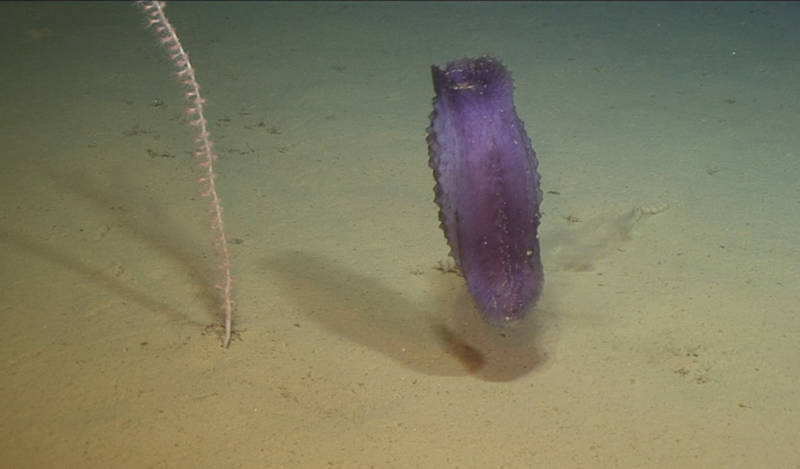
Swimming elasipod holothuroid (sea cucumber). Image courtesy of NOAA Bioluminescence and Vision on the Deep Seafloor 2015. Download larger version (jpg, 246 KB).
My particular area of expertise is the crinoids, the sea lilies and feather stars. Crinoids are echinoderms along with sea stars, sea urchins, sand dollars, sea cucumbers, and brittle stars. About 55 species have been described from the western Atlantic, most from deep water. We’ve only seen a few so far and have only collected three specimens. Two little ones belong to one species of uncertain identity. The other represented another “aha moment,” because, as soon as I looked at it under the microscope, I recognized it as a species of Thaumatocrinus, even though I had never seen one before. As my grad student, Brenna, reported earlier, members of this genus are unique among feather stars in having 10 undivided rays. But, even as an expert, I’ll have to take all of these specimens back to my lab, examine them in detail, and compare them with previously identified material before I can be sure about their identities, or if they perhaps represent undescribed species.
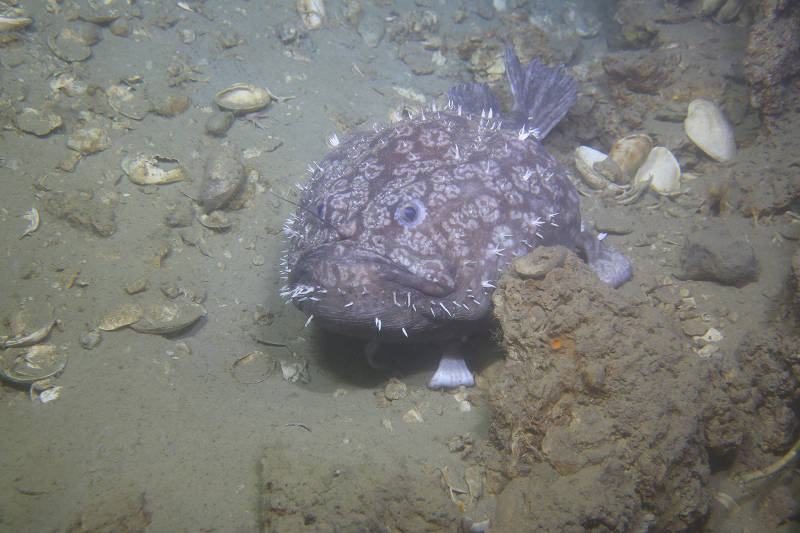
Goosefish. Image courtesy of NOAA Bioluminescence and Vision on the Deep Seafloor 2015. Download larger version (jpg, 2.0 MB).
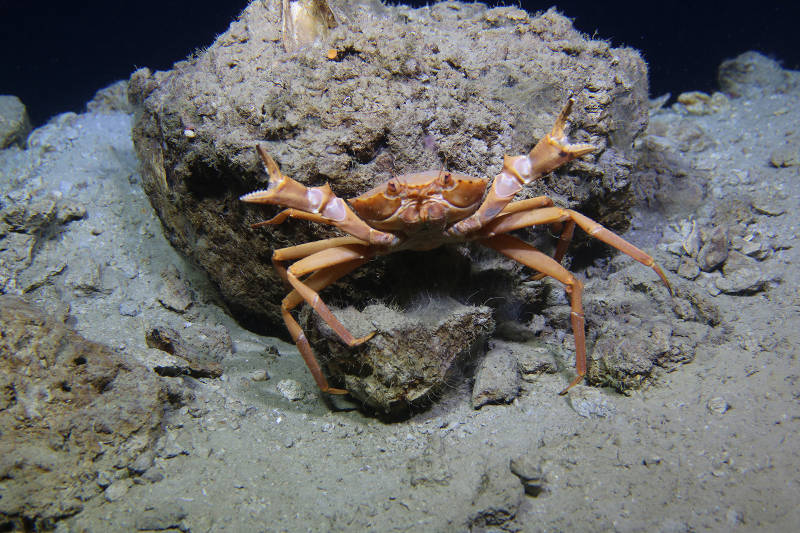
Chaceon sp. crab. Image courtesy of NOAA Bioluminescence and Vision on the Deep Seafloor 2015. Download larger version (jpg, 2.6 MB).
It’s one thing to point out that a thick-branched yellow sea fan is actually a stony coral—it doesn’t bend in the current, and broken pieces on the seafloor at its base are brittle—it’s entirely another to put a specific name on it. In some cases, we can do this once we get the specimen on board and examine it closely, often under a microscope. This yellow fan turned out to be Enallopsammia rostrata. I was able to identify it, because there are only about half a dozen deep-sea branching corals in this part of the world, and the calices—the cups into which the polyps withdraw—of E. rostrata have a uniquely projecting nose, or rostrum. That was an example of the satisfaction component—the “aha moment” of recognition when you say “I’ve seen this before” or “I saw a picture of this once.” In most cases, however, there are so many species in a group, or they are still poorly known, that it takes an expert in the particular group to identify the specimen, and sometimes even they don’t know.
I can recognize a fuzzy whip or what looks like an ice-covered leafless sapling as a bamboo coral in family Isididae, but I’m no expert. So, once we have a sample on board and verify its identity as specifically as possible (in this case to family), we photograph it (again, often under the microscope), and preserve portions of it in different solutions—formalin for histology, ethanol for DNA and genetic sequencing, and RNALater for gene expression. After the cruise, we’ll send these to different taxonomists for further study.